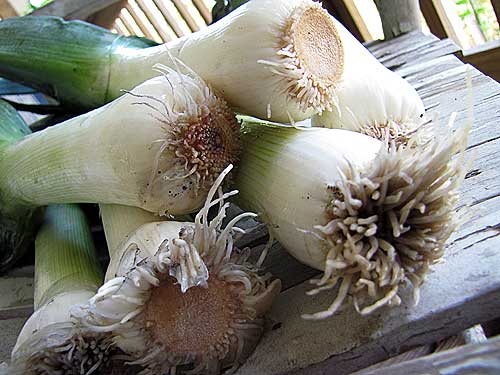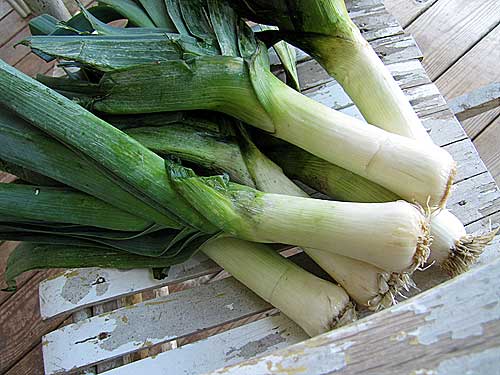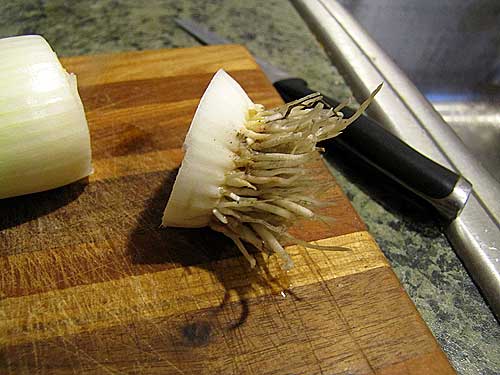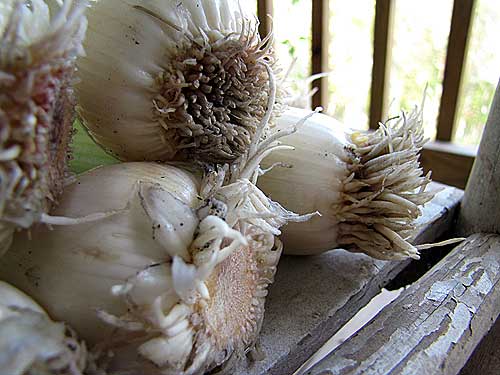
I picked up these leeks the other day at the store and I was stopped twice on the way out.
“Are those leeks? What do you do with leeks?”
Around here, the easiest way to explain leeks is to tell people they are similar to ramps–because around here, everyone knows what ramps are. Ramps are wild leeks, and they are all part of the same root vegetable family with onions, garlic, chives, and so on–the genus Allium. They each just have their own unique taste. The leeks you will find in the grocery store are much milder than wild leeks (ramps).

I’ve been planting ramps on our farm for the past three years, with quite a bit of success (see here), and it finally occurred to me that I could plant leeks, too–the same way I plant ramps. Just cut off the bottoms and stick ’em in the ground. How easy is that? (No messing with seeds!) Cut the bottoms off about an inch or so above the rooty ends.

Dig a hole a few inches deep. Place the leek bottom in the ground rooty bits down. Cover with soil. Water them in then leave ’em alone.
Leeks, like ramps and other root vegetables, like to simmer underground in cold temperatures. I’ll plant them now, and watch them come up in the spring.
Leave them alone for a few years, and they’ll spread.
The white base is the most commonly used part, and as leeks grow, mound up the soil around the base to increase the proportion of white root versus green leaves in the final result. The leaves of the leek plant are edible, too, though, just as with ramps. The leaves are most often used in vegetable stocks, but you can slice them up and saute them, too.
To prepare leeks for cooking, rinse well then trim off the root end (save to plant!) and cut the leaves away. Slice up the white portion and the leaves, if using. (Discard any leaves that seem particularly tough.) You can use them in all the same ways you might use ramps, onions, garlic, chives, etc. to add flavor to a dish, or even create a dish around them as the centerpiece ingredient.
If you think onions, and especially ramps, are too strong for your tastes, you might love leeks–they are milder. Leeks are the little Alliums who went to Sunday School while the ramps and onions were getting drunk and rowdy at the bar. Try them!

And don’t forget to cut off the bottoms and plant ’em!


Flatlander says:
I LOVE LEEKS, I have a very tasty recipe for it too.
should post that soon in FBR.
I eat leek my whole life already and have them in my garden every year..(that is except this year, since my garden is a huge disaster this year.)
But I have never know you could get a big forever patch by planting the roots back.
Thanks for sharing.
On September 16, 2010 at 1:37 am
Karen Anne says:
Someone post a recipe…. Thank you.
On September 16, 2010 at 1:48 am
Woodwife says:
Potato leek soup…. :heart:
On September 16, 2010 at 1:51 am
jan~n~tn says:
??? How does it grow more than one leek, from one root-base? Wouldn’t you have to split the base in half or quarters, for it to multiply?
On September 16, 2010 at 2:19 am
Suzanne McMinn says:
Jan, they multiply the same way ramps do if you leave them alone.
Frank, you’re supposed to mound up dirt around them as they start growing.
On September 16, 2010 at 7:19 am
Frank says:
That’s interesting to hear, I had never heard of leeks self-propagating like this. Definitely worth a try, though, if you plant them just and inch down, the white stem part will be rather short, isn’t it?
On September 16, 2010 at 2:37 am
margaret rusnak says:
i second the potato/leek soup. :snoopy: love soup season
On September 16, 2010 at 2:50 am
Sirje says:
Thanks for clearing up that ramp/leek connection. We don’t see any ramps here but leeks are everywhere. We use them in everything, but my husband’s favorite recipe is a simple leek and carrot bake with whatever cheese is around (though the best is gruyere and a little creme fraiche) and some chicken broth. It’s impossible to mess up, so you can use any proportion of sliced carrots and sliced leeks (light green and white parts only) and however much cheese you like in a shallow baking dish, with about a cup of broth over the top.
On September 16, 2010 at 6:51 am
RockWhisperer says:
I wonder if the “wild onions” that the Delaware and Cherokee Indians in these parts use in their wild onion dinners in the spring are the same thing you call ramps?
I planted some elephant garlic from the store. Now I’m told elephant garlic is actually in the leek family.
I always enjoy your posts. Hugs, Ilene in Oklahoma
On September 16, 2010 at 7:01 am
CindyP says:
They went to Sunday School! LOL!!
I love leeks, they’re mild and just add a little sumpin sumpin. I didn’t know (buy why couldn’t you after the celery) could plant it right back in the ground. Soon the grocery store will be of no use!
On September 16, 2010 at 7:23 am
Patrice says:
I love leeks. I have used them at work for years and always tossed the base. Who would have thought that I could plant them? Wow! I never new that onions and ramps were so rowdy!No wonder the onions are always rolling off the display at the store.
On September 16, 2010 at 7:28 am
Glenie says:
Thanks for the info on the leeks, ramps, onions. Interesting!
On September 16, 2010 at 7:33 am
Heather says:
I am headed to the yucky dreadful grocery store today. I may just have to pick up some leeks. We have never eaten leeks, I didn’t know how to use them *hangs head in shame* I love onions, my kids aren’t huge fans. Maybe they will like leeks? Thanks for the post 😀
On September 16, 2010 at 9:02 am
Tina says:
I love leeks! I didn’t know you could plant them thusly, thanks Suzanne! I’m trying it!
On September 16, 2010 at 9:21 am
Melissa says:
I always wash, then cut then wash them again (in a colander separating the the layers) as they seem to have dirt between the layers of growth. Next time I buy leeks I’ll try planting them. Thanks for the tip.
On September 16, 2010 at 9:50 am
Mim says:
Always something useful on here…. :pawprint:
On September 16, 2010 at 10:03 am
Helen says:
Aren’t leeks bi-annuals, though? What I mean is that, yes, they will grow, but in it’s second year, the leek sends up a stem for a flower and the result is a few leaves with a core in the middle. Have you ever gotten leeks from the store that have a core in them? If you have, then the growers are cheating and you got second-year leeks 😕 . Although maybe it will work to re-plant them, if you harvest early before the re-planted leeks send up the flower stalk.
On September 16, 2010 at 10:42 am
Suzanne McMinn says:
Helen, if you want them to spread, you actually need to leave your patch alone for several years. You can harvest them the first year, but then that’s all you’ll get. With my ramps, for example, I’ve been planting them for three years now. I still haven’t harvested a one. I won’t think about harvesting any of them until it’s been at least five years, and then I won’t take them all.
On September 16, 2010 at 10:48 am
Andrea the Kitchen Witch says:
Will this work with store bought leeks? How cool, I never knew it was that simple to propagate leeks 🙂
On September 16, 2010 at 11:04 am
Suzanne McMinn says:
I’m using store-bought leeks, Andrea.
On September 16, 2010 at 11:11 am
Helen says:
“..You can harvest them the first year, but then that’s all you’ll get…”
But we are talking about replanting roots, and when you replant a grocery store leek, when it comes up, by definition it is already in its second year, and being a bi-annual, it will send up a flower stalk and you will not get that those nice concentric circles of leaves, what you will get is a “core” of flower stalk. To get a useful harvest from replanted grocery store leeks, if you plant them in the fall, you would have to wait for two and a half years…plant the roots the first year, let the plant grow and go to seed the second year, plant the seeds from it, and then harvest the leeks from those seeds in the fall. See?
p.s. Celery works the same way. Have you ever gotten a bunch of celery from the store with an obvious flower stalk growing in the middle of the bunch? That is because the celery was harvested in its second year. I wouldn’t be surprized if celery growers sell the first-year’s batch to the processed-food market and then pass on the second-year’s growth to the fresh market. It makes economic sense for them to do this, and usually, the consumer is none the wiser.
On September 16, 2010 at 12:11 pm
Suzanne McMinn says:
Helen, I think we are talking about the same thing as that is what I’m doing, planting and leaving them, as I do with my ramps.
On September 16, 2010 at 12:16 pm
Helen says:
p.s. I’m not saying that it isn’t a good thing to do (to re-plant leek roots)…in fact I think its a totally cool idea! But leeks are bi-annuals, like celery and parsley, and bi-annuals always send up a flower stalk in their second year, and if you are re-planting roots, then the plant has already lived its first year of life.
On September 16, 2010 at 12:17 pm
Helen says:
Yes, we are…sorry for my confusion, Suzanne. I think what threw me was that you don’t say anywhere why you are leaving them, other than so that they will spread.
On September 16, 2010 at 12:33 pm
Suzanne McMinn says:
Helen, I don’t always know *why* things work, just that they *do*, LOL. (I’m sure you’re right about the why!)
On September 16, 2010 at 12:36 pm
Ivy says:
Thank you so much for this planting hint. Always looking for new ways to help my garden spread.
On September 16, 2010 at 12:47 pm
Karen says:
I’d always assumed that your ramps were what are known here in England as ramsons. But a bit of research clarified that ramsons = wild garlic = Allium ursinum whereas ramps = = wild leeks = Allium tricoccum. Apparently we don’t get ramps over here. But we’ve definitely got garden leeks, so I might have a go with re-growing the bottoms.
On September 16, 2010 at 1:15 pm
Helen says:
Uh, oh…my inner mad scientist has woken up. Next year, I’m going to save a little patch of garden and try this with all sorts of veggies. Thanks for being so inspirational, Suzanne…you rock :shimmy:
On September 16, 2010 at 3:01 pm
lavenderblue says:
Of course, for me the question, as always, was “Will they grow up North?”, but if Flatlander grows them, well, she’s “north-er” than me. The only thing that concerns me is there is a flower called “Star of Bethlehem”, really pretty but really poisonous (according to my mom) that looks like chives, smell like onions. I don’t even know if ramps or wild onion grow around here, (Western NY) but I’ve always been afraid to gather anything onion-y because of those flowers. I even grow my chives in pots although the flowers are really different between the two.
On September 16, 2010 at 3:04 pm
Mel Chern says:
Do you or anyone here know if leeks planted this way are hardy in the Northeast (zone 5?). I’d never heard this before and now feeling a bit embarrassed that I harvested my leeks yesterday and composted the ends. Spent a good bit of time rummaging through compost heap pulling ends out (may have salvaged about 12?). Thanks for the info, love your blog 🙂
On September 16, 2010 at 5:22 pm
Nemo's Daily Dabble says:
:woof: Thanks for this cool tip! I LOVE leeks but always throw the rooties out… I’d like to try this :airkiss:
On September 16, 2010 at 5:40 pm
becky3086 says:
Very interesting! I have always planted my green onion bottoms and even regular onion bottoms will grow again. I like this leek recipe and I will see if there are any leeks in the store so that I can try it and plant the bottoms. Thanks!
On September 17, 2010 at 7:45 am
Jean says:
Great idea! Never thought of it…thank you, I love your web site you have such great information and I admire your life..it is what I would love to do! :clover: >
On September 17, 2010 at 9:35 am
farmershae says:
Love love love Potato Leek soup. Throw a few chunks of Blue Cheese on top and MMMM MMMM GOOD!!! Will have to try this planting method!!
On September 17, 2010 at 12:42 pm
Deborah says:
Wow… I had no idea you could just plant a leek like that! Very cool and great to know! Thanks!!
On September 17, 2010 at 1:28 pm
Flatlander says:
Lavender Blue I seed them every year, I don’t know if they will survive a winter.
But from seed to table is same season, so I don’t think I will keep the roots and replant.
For me it is just easier to seed.
I start (due to our short summers) indoors, when they are about as thick as a pencil, I plant them outside about 4 to 5 inches deep.
Keep adding soil against them when they grow.
I harvest, cut them up, freeze them raw in bags and take out what I need.
Next year I buy a little tiny bag of seeds, and grow them again.
On September 17, 2010 at 3:53 pm
laurajenkins says:
Does anyone know if you can pick ground cherries green and ripen in the house like you do tomatoes? I have a bumper crop but I’m afraid that snow will fall before they ripen and fall to the ground…The chipmunks are sneaking in the garden and dining on what has fallen to the ground and nibbling on baby yellow squash.
On September 29, 2010 at 11:56 am
stacylee says:
I love leeks, I planted my celery bottoms like you said some time ago and it totally worked! How did I never think to try it with leeks! Oh how I wish it was not December…
On November 16, 2011 at 1:41 pm
Caeruleuslady says:
Hi. I wanted to ad that I only use the green part for cooking, so I have the whole white part and some green left to plant. Since it’s getting cold I just put them in potting soil in the house. It’s been less than a week(for my new lerk babies) with just wetting the soil and misting the plant and they’ve already grown several inches.
On September 29, 2012 at 10:42 pm